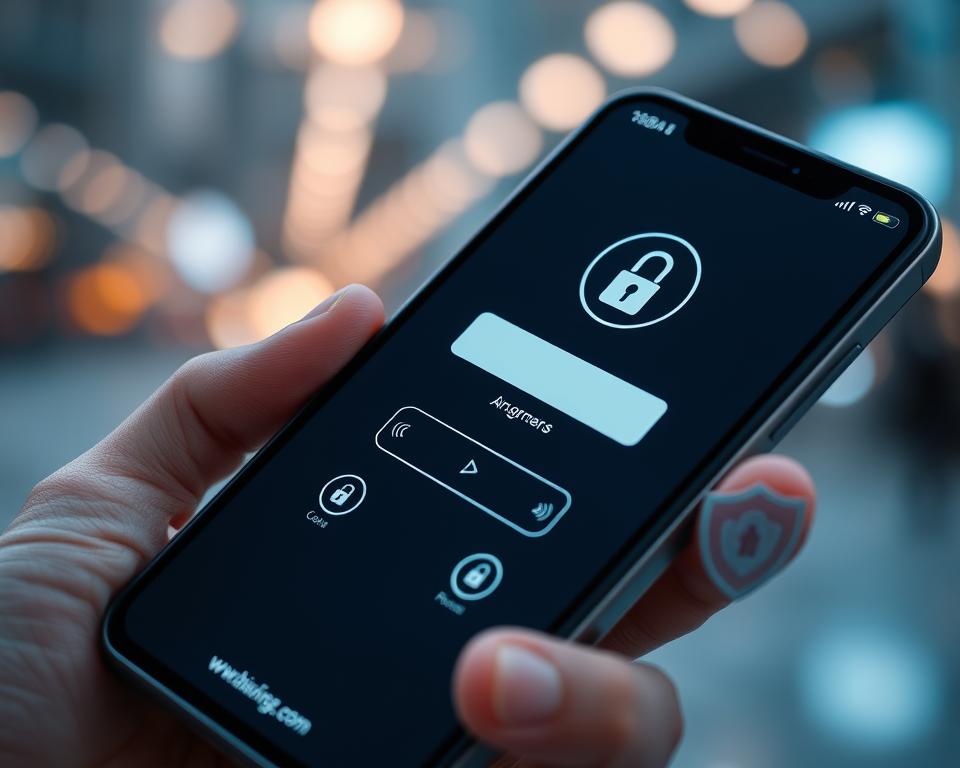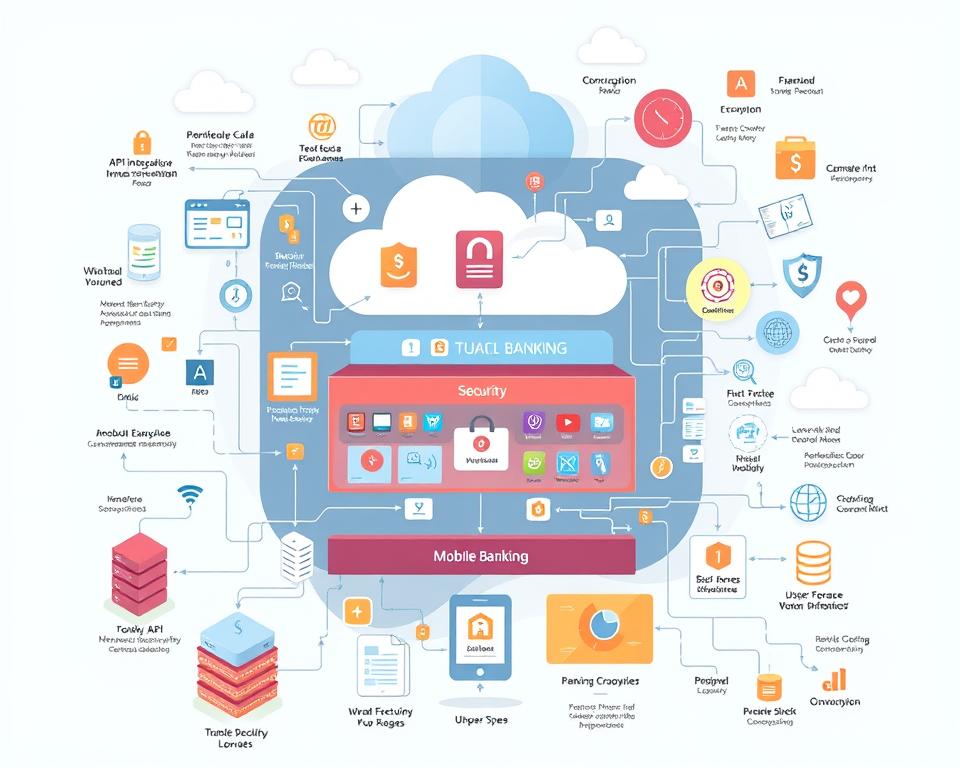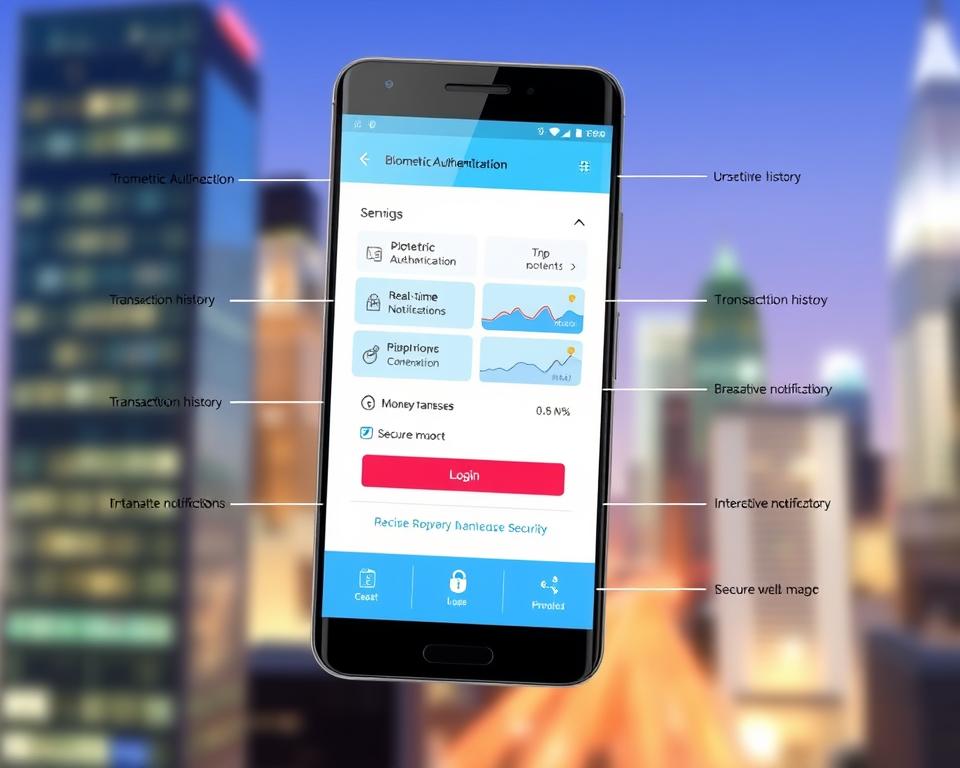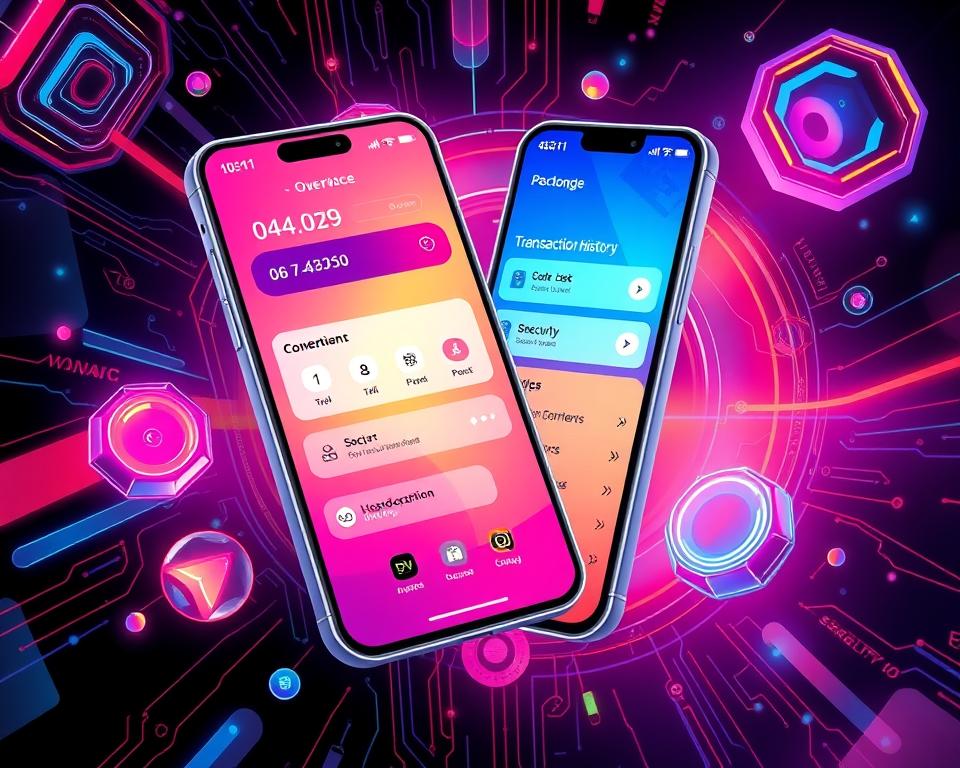The rise of mobile banking has changed the financial world. It offers customers easy and accessible banking options. But, with more cyber threats, making secure mobile banking apps is key. This guide covers the must-have features and security steps for a safe and easy-to-use app.
Mobile banking is now a big part of managing personal finances. People want easy and safe access to their money and transactions. This article talks about making a secure mobile banking app. It covers market trends, app development needs, and how to keep data safe.
Table of Contents
Key Takeaways
- Understand the current market trends and user demands in the mobile banking industry.
- Ensure the app’s development adheres to essential prerequisites, such as regulatory compliance and technology stack selection.
- Implement robust authentication and authorization mechanisms, including biometric and multi-factor authentication.
- Prioritize data encryption and protection standards to safeguard customer information.
- Incorporate key features like account management, payment processing, and digital wallet integration.
Understanding Mobile Banking App Development Fundamentals
The mobile banking world is always changing. It’s key for developers to know the latest trends, what’s needed, and the best tech to make secure and easy-to-use apps. This part covers the main points of making mobile banking apps, helping you understand this fast-paced field.
Current Market Trends in Mobile Banking
Mobile banking has grown a lot lately, thanks to more people using smartphones. Reports say mobile banking transactions will hit $14 trillion worldwide by 2023. This shows how big the chance is in this area. People want easy, quick, and full-featured mobile banking, so banks must keep up.
Essential Development Prerequisites
- Strong security: Use things like multi-factor authentication, biometrics, and top encryption to protect data and transactions.
- Easy user experience: Make interfaces simple, with clear paths and layouts that work well on all devices.
- Smooth integration: Make sure the app works well with current banking systems and new tech.
- Follow rules: Stick to rules like PCI DSS, GDPR, and local banking laws.
Technology Stack Selection
Picking the right tech stack is key for a mobile banking app’s success. Think about how well it works, how it grows, its safety, and if developers know it well. Some top tech stacks for mobile banking apps include:
| Component | Examples |
|---|---|
| Front-end | React Native, Flutter, iOS Swift, Android Kotlin |
| Back-end | Node.js, Java Spring, Python Django, .NET Core |
| Database | MongoDB, PostgreSQL, MySQL, Couchbase |
| Cloud Platform | Amazon Web Services (AWS), Microsoft Azure, Google Cloud Platform |
Knowing the latest mobile banking trends, app development needs, and the best tech stack helps developers build safe, user-friendly, and ready-for-the-future mobile banking apps.
Security Requirements for Mobile Banking Applications
Creating a secure mobile banking app is key in today’s digital world. Banking app security, data protection, and cybersecurity are essential. Mobile banking apps must follow strict security rules to keep user info safe and private.
One major security step for mobile banking apps is strong data encryption. Using top encryption like AES and RSA, apps can protect sensitive user data. This includes account and transaction details from unauthorized access.
| Security Requirement | Description |
|---|---|
| Data Encryption | Ensure that all user data is encrypted using industry-standard algorithms to prevent unauthorized access. |
| Cybersecurity Measures | Implement robust cybersecurity measures, including firewalls, intrusion detection systems, and regular security updates, to safeguard the app and its infrastructure from cyber threats. |
| Data Protection | Ensure that user data is stored securely and that access to sensitive information is strictly controlled and monitored. |
Mobile banking apps also need strong cybersecurity to protect against threats. This includes using firewalls, intrusion detection systems, and keeping the app updated to fix security issues.
By focusing on these key security needs, app developers can build a safe and reliable platform. This platform will protect user data and build trust with customers.
Authentication and Authorization Mechanisms
Mobile banking apps need strong security to keep user data safe. Biometric and multi-factor authentication are key to this. They help prevent unauthorized access.
Biometric Authentication Options
Biometric authentication uses unique traits to confirm identity. Fingerprint, facial, and voice recognition are common in mobile banking. They make logging in easy and secure.
Multi-Factor Authentication Implementation
MFA adds an extra security layer. It asks for more than one form of ID, like a password and a code. This makes it harder for hackers to get in, even if they guess one thing right.
Session Management Best Practices
Good session management is vital for app security. It includes setting automatic timeouts and using secure tokens. It also means watching for any odd activity. This helps prevent hackers from taking over a session.
| Authentication Method | Advantages | Challenges |
|---|---|---|
| Biometric Authentication |
|
|
| Multi-Factor Authentication |
|
|
Using biometric, MFA, and good session management makes mobile banking apps much safer. It helps protect user data from unauthorized access.
Data Encryption and Protection Standards
Keeping financial info safe is crucial in mobile banking apps. To protect user data, it’s vital to use strong encryption protocols and follow data protection standards.
Choosing the right encryption protocols is key. They keep data safe as it moves between the app and servers. Standards like AES, RSA, and SHA-256 are common and often required by law.
Mobile banking apps also need to follow specific data protection rules. These include the Payment Card Industry Data Security Standard (PCI DSS) and the General Data Protection Regulation (GDPR). These rules help keep user data safe and ensure the app follows the law.
| Encryption Protocol | Key Features | Application in Mobile Banking |
|---|---|---|
| AES (Advanced Encryption Standard) | Symmetric-key encryption algorithm, efficient performance, and government-approved security | Protecting sensitive data, including account information, transaction details, and personal identification numbers (PINs) |
| RSA (Rivest-Shamir-Adleman) | Asymmetric-key encryption algorithm, widely used for secure data transmission and digital signatures | Implementing secure communication channels, user authentication, and data integrity verification |
| SHA-256 (Secure Hash Algorithm) | Cryptographic hash function, providing data integrity and message authentication | Ensuring the integrity of sensitive data, such as account balances, transaction histories, and user credentials |
By using these strong encryption methods and data protection rules, developers can keep user info safe. This ensures secure communication in the app at all times.
Key Features for Modern Mobile Banking Apps
Mobile banking is changing how we handle money. Today, apps need to be full-featured and safe. They must offer account management, easy mobile payments, and digital wallet integration. These features are key to attracting and helping today’s tech-savvy users.
Account Management Functions
Mobile banking apps need to have good account management tools. Users should be able to track their balances, see transaction history, and move money between accounts easily. This helps users manage their money well and make smart choices anytime, anywhere.
Payment and Transfer Capabilities
Modern apps must make payments and transfers simple. Users should be able to pay securely, transfer money, and send funds to others with just a few taps. This makes using the app better and encourages more people to use it.
Digital Wallet Integration
Digital wallet integration is a big plus for mobile banking apps. It lets users link their bank accounts and cards to their favorite digital wallets. This makes it easy to handle all kinds of financial transactions, from shopping in stores to online.
| Feature | Description |
|---|---|
| Account Management | Real-time balance tracking, transaction history, and fund transfers between accounts |
| Mobile Payments | Secure and seamless in-app payment processing and money transfers |
| Digital Wallet Integration | Ability to connect bank accounts and cards to popular digital wallets |
“Integrating cutting-edge features like digital wallet support and seamless payment capabilities is crucial for mobile banking apps to stay competitive and meet the evolving needs of tech-savvy consumers.”
Regulatory Compliance and Legal Requirements
Creating a secure mobile banking app means knowing all about financial rules and laws. Banks must follow strict rules to keep customer data safe and ensure financial transactions are secure.
Mobile banking apps must follow rules from the Federal Reserve and the Consumer Financial Protection Bureau (CFPB). These rules cover important areas like data privacy, security, and protecting consumers.
- Data Privacy: Apps must follow laws like the Gramm-Leach-Bliley Act (GLBA) and the General Data Protection Regulation (GDPR). This ensures customer info is kept safe.
- Compliance with Security Standards: Apps need to follow security standards like the Payment Card Industry Data Security Standard (PCI DSS). This helps protect financial transactions and prevent unauthorized access.
- Legal Framework for Financial Transactions: Apps must follow laws for electronic fund transfers, anti-money laundering, and other financial rules. This helps keep users’ trust and confidence.
By keeping up with financial regulations, compliance needs, and legal framework, app developers can make sure their apps are safe and meet standards. This protects customers’ financial health.
“Compliance with financial regulations is not just a legal requirement, but a crucial aspect of building trust and credibility with our customers.”
User Interface Design for Banking Applications
Mobile banking apps rely heavily on UI and UX design for a good user experience. Designers must focus on making these apps easy to use and visually appealing. They need to follow key principles to ensure the apps are both functional and enjoyable.
Design Principles for Financial Apps
Good UI/UX design for banking apps means keeping things simple and clear. The layout should be clean and easy to navigate. This makes it simple for users to find and use important features.
Information should be easy to understand. Labels and instructions should help users manage their accounts and make transactions smoothly.
Accessibility Guidelines
- Make sure the app works well with assistive technologies for users with visual impairments.
- Use high-contrast colors and adjustable text sizes for better readability.
- Use clear and simple language in the app to help users understand it better.
- Design the app to be easy to use with one hand, keeping key actions within thumb’s reach.
Navigation Patterns
Choosing the right navigation patterns is key for mobile banking apps. It’s important to use patterns that users find familiar and easy to use. This includes:
- A clear and consistent menu that makes it easy to find what you need.
- Swipe gestures for quick access to account details and transaction history.
- Contextual menus and pop-ups that offer relevant actions based on where you are in the app.
By following these design principles and guidelines, developers can create banking apps that are easy to use and enjoyable. This leads to happy customers who trust and use the app regularly.
Backend Infrastructure and API Integration
Creating a secure and scalable mobile banking app needs a strong backend. This system must handle the growing needs of banking today. At its heart are the backend systems that make the app work, linked by a detailed API integration plan. This ensures smooth data sharing and a unified user experience.
Building a successful mobile banking app means focusing on scalability. As more users join and the app grows, the backend must adjust. It should handle more traffic without losing speed or security. This requires smart system design, cloud use, and effective data handling.
- Use cloud-based backend systems for scalable and reliable setup. This lets your app manage sudden user increases well.
- Have a strong API integration plan. It connects your app to banking systems, third-party services, and more.
- Choose a microservices-based backend. This lets you scale parts separately for better scalability.
- Use caching and optimize data to make your app fast and responsive, even when busy.
“Investing in a well-designed backend infrastructure and API integration is crucial for the long-term success of your mobile banking app. It allows you to deliver a fast, secure, and scalable user experience that will keep your customers satisfied and loyal.”
Focus on a secure and scalable backend system with a solid API integration plan. This prepares your mobile banking app for today’s banking needs. It ensures a top-notch user experience that will make you stand out.
Testing and Quality Assurance Protocols
Creating a secure and efficient mobile banking app needs a detailed testing plan. This plan includes strict security testing, careful performance optimization, and detailed user acceptance testing (QA process). These steps help make sure your app is top-notch in function, security, and user experience.
Security Testing Methods
Protecting customer data is key in mobile banking. Use strong security testing methods, such as:
- Penetration testing to find and fix weaknesses
- Static and dynamic code analysis to spot security issues
- Secure coding and regular code checks
- Testing how the app handles login and access control
- Checking data encryption and protection
Performance Testing Requirements
Make your mobile banking app fast and smooth for users. Do thorough performance testing, like:
- Load and stress tests to see how the app handles lots of users
- Checking how fast the app responds and finding slow spots
- Looking at how the app uses resources and grows
- Improving caching and data syncing
User Acceptance Testing
Get feedback from users during development to check the QA process. Use user acceptance testing (UAT) to make sure the app meets user needs, including:
| Testing Objective | Evaluation Criteria |
|---|---|
| Functionality | Make sure all main banking features work right |
| Usability | Check if the app is easy to use and navigate |
| Security | Test how well the app protects user data |
By following these detailed testing and quality assurance protocols, you can make sure your mobile banking app is safe, works well, and meets customer needs.
Real-Time Transaction Processing Systems
In today’s fast world, mobile banking needs to process transactions quickly. Real-time transactions are key, thanks to strong payment processing systems. These systems are essential for smooth financial operations in mobile banking apps.
For a great user experience, mobile banking apps must handle transactions fast. They should instantly approve, check, and finish transactions. This gives users quick feedback and reassurance.
Leveraging Real-Time Transaction Processing
Setting up a good real-time transaction system in your app is important. Here are some key points:
- Connect with secure payment gateways for quick transaction processing
- Use strong fraud detection to protect against unauthorized activity
- Make sure the system can handle lots of transactions at once without slowing down
- Make the app’s interface show real-time updates on transactions
By focusing on real-time transaction processing, you can make your app better. It will offer a smooth and safe financial experience for users.
| Key Benefits of Real-Time Transaction Processing | Metrics to Measure Success |
|---|---|
|
|
Adding real-time transaction processing to your app improves the user experience. It also makes your app more secure and efficient in financial operations.
Fraud Detection and Prevention Measures
Protecting mobile banking apps from fraud is key for banks. They use AI-powered security features, transaction monitoring systems, and risk assessment tools to fight fraud.
AI-Powered Security Features
Artificial intelligence (AI) has changed how banks fight fraud. AI security features use machine learning to spot odd behavior and transactions. This helps banks catch fraud fast, making mobile banking safer.
Transaction Monitoring Systems
Mobile banking apps also have transaction monitoring systems. These systems watch all transactions and flag anything odd. This way, banks can quickly stop fraud, keeping customers’ money safe.
Risk Assessment Tools
To fight fraud better, banks use risk assessment tools. These tools check user activities and transactions to find risks. By always checking and updating risks, banks can keep mobile banking safe and easy for customers.
| Feature | Description | Benefits |
|---|---|---|
| AI-Powered Security | Machine learning-based fraud detection and prevention | Real-time anomaly identification, proactive threat mitigation |
| Transaction Monitoring | Continuous tracking and analysis of financial transactions | Rapid detection and response to suspicious activities |
| Risk Assessment Tools | Data-driven evaluation of user, transaction, and device risk | Adaptive security measures, enhanced customer protection |
“Effective fraud prevention is not just about catching the bad guys; it’s about empowering customers to confidently and securely manage their finances on the go.”
App Maintenance and Update Strategies
In the fast-changing world of mobile banking, keeping your app secure and performing well is key. Good app maintenance and software updates are vital for a smooth user experience. This ensures your mobile banking app stays a reliable choice for your customers.
Staying ahead means embracing a culture of continuous improvement. Regularly check user feedback and analyze how people use your app. This helps you find areas to improve and make updates that really matter. By fixing bugs, improving performance, and adding new features, your app will always be at its best. It will also meet your customers’ changing needs.
- Have a clear app maintenance plan to fix security issues, performance problems, and bugs quickly.
- Make a solid software update plan. It should balance new features with keeping your app stable and reliable.
- Use user analytics and feedback to find ways to improve your app. This keeps it relevant and fun for users.
By being proactive and diligent with app maintenance and software updates, your mobile banking app will stay secure and top-notch. This dedication to continuous improvement will boost customer trust. It will also make your app a leader in the fast-paced mobile banking world.
Performance Optimization Techniques
Creating a top-notch mobile banking app is key for a smooth user experience. To make sure your app performs well, try these optimization tips:
Load Time Reduction
Make your app load faster by optimizing images and scripts. Use caching, content delivery networks (CDNs), and lazy loading to boost speed.
Resource Management
Manage your app’s resources like memory and battery to keep it running smoothly. Watch and tweak background tasks, network requests, and data syncing for better app performance.
User Experience Optimization
Improve the user experience with smooth animations and quick UI. Keep checking for any user experience issues and fix them with A/B testing and user feedback.
| Optimization Technique | Benefits |
|---|---|
| Image and Asset Optimization | Reduced page load times, improved perceived performance |
| Caching and CDN Utilization | Faster content delivery, reduced server load |
| Lazy Loading | Improved initial load times, reduced data usage |
| Memory and Battery Management | Efficient resource utilization, extended battery life |
| Smooth Animations and Responsive UI | Enhanced user experience, better engagement |
By using these app performance tips, you can offer a fast, smooth, and fun mobile banking app. Your customers will love it.
Conclusion
Creating a secure mobile banking app is a challenge. It needs strong security, easy-to-use features, and to keep up with new financial tech. As more people want easy and safe digital banking, following the best practices for app development is key.
Financial institutions should focus on keeping customer data safe. This includes using strong authentication, encrypting data, and processing transactions quickly. Also, using app development best practices like testing and fraud detection makes the app more secure and reliable.
The future of financial technology is exciting but also requires careful attention to security. Banks need to stay alert to new threats and rules. By doing so, they can offer their customers a safe and easy banking experience. This will help them stay ahead in the fast-changing financial world.



















